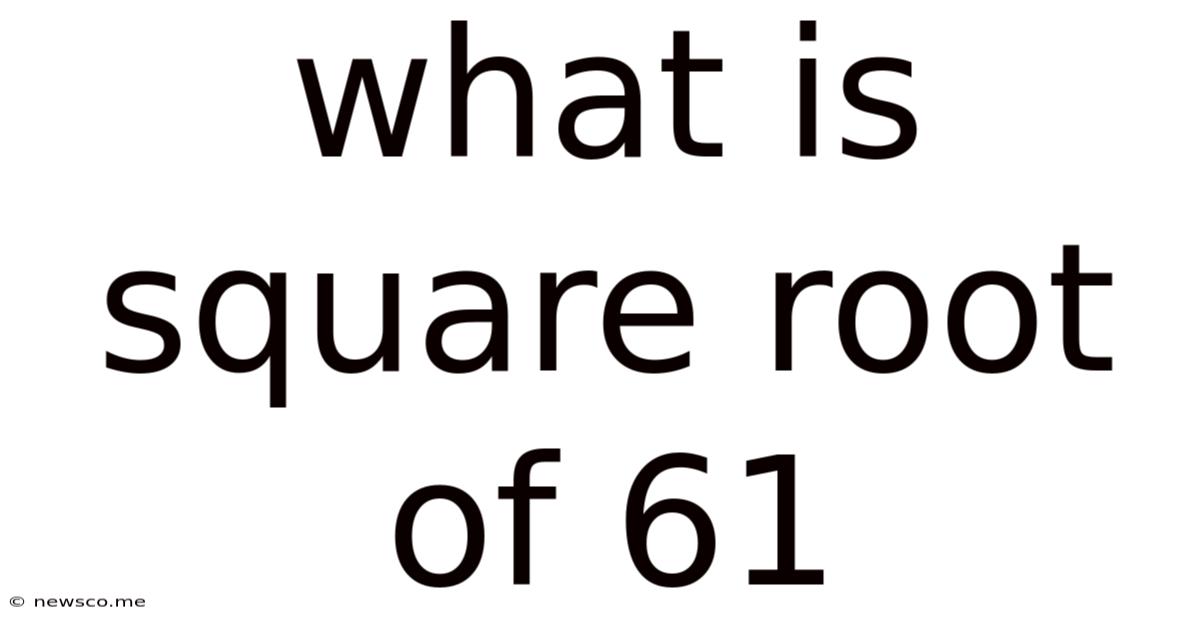What Is Square Root Of 61
News Co
Mar 31, 2025 · 5 min read

Table of Contents
What is the Square Root of 61? A Deep Dive into Irrational Numbers
The seemingly simple question, "What is the square root of 61?" opens a door to a fascinating world of mathematics, specifically the realm of irrational numbers. While a simple calculator will give you a decimal approximation, understanding the true nature of √61 requires delving deeper into its properties and implications. This article explores the square root of 61, its approximations, and its relevance within broader mathematical concepts.
Understanding Square Roots
Before tackling √61, let's refresh our understanding of square roots. The square root of a number (x) is a value that, when multiplied by itself, equals x. In simpler terms, it's the inverse operation of squaring a number. For example:
- The square root of 9 (√9) is 3, because 3 x 3 = 9.
- The square root of 16 (√16) is 4, because 4 x 4 = 16.
Why √61 is Special: Irrational Numbers
Unlike the examples above, the square root of 61 (√61) is not a whole number or a simple fraction. It's an irrational number. This means it cannot be expressed as a simple fraction (a/b) where 'a' and 'b' are integers, and 'b' is not zero. Irrational numbers have decimal representations that are non-terminating (they don't end) and non-repeating (they don't have a recurring pattern).
This characteristic of √61 makes it unique and necessitates exploring various methods to approximate its value.
Approximating √61: Methods and Techniques
Several methods can be employed to approximate the value of √61:
1. Using a Calculator: The Simplest Approach
The most straightforward method is to use a calculator or computer software. A calculator will provide a decimal approximation, typically accurate to several decimal places. You'll find that √61 is approximately 7.8102496759. However, remember this is only an approximation; the actual value extends infinitely without repetition.
2. The Babylonian Method (or Heron's Method): An Iterative Approach
The Babylonian method is an iterative algorithm that refines an initial guess to get progressively closer to the actual square root. Here's how it works:
- Make an initial guess: Let's start with 8, as 8² = 64, which is close to 61.
- Improve the guess: Divide 61 by the initial guess (61/8 = 7.625).
- Average the results: Average the initial guess and the result from step 2: (8 + 7.625)/2 = 7.8125.
- Repeat: Use 7.8125 as the new guess and repeat steps 2 and 3. Each iteration brings the approximation closer to the true value.
This process can be repeated until the desired level of accuracy is achieved. The Babylonian method demonstrates a practical approach to approximating square roots without relying solely on a calculator.
3. Linear Approximation: A Simpler Estimation
For a quick, rough estimate, we can use linear approximation. Since √64 = 8 and √49 = 7, and 61 lies between 49 and 64, we can estimate √61 to be somewhere between 7 and 8. A more precise linear interpolation could further refine this estimate.
4. Continued Fractions: An Elegant Representation
Continued fractions offer an elegant way to represent irrational numbers. √61 can be expressed as a continued fraction:
7 + 1/(1 + 1/(1 + 1/(3 + 1/(1 + 1/(1 + 1/(3 + ...))))))
While this representation doesn't directly provide a decimal approximation, it highlights the inherent complexity of irrational numbers and provides an alternative way to express √61.
The Significance of √61 in Mathematics
While √61 might seem like a relatively insignificant number, its irrational nature showcases fundamental concepts in mathematics:
- Real Numbers: √61 is a real number, meaning it lies on the number line. Understanding irrational numbers is crucial for comprehending the completeness of the real number system.
- Number Theory: √61's properties are relevant to number theory, a branch of mathematics that studies integers and their relationships. Its irrationality impacts theorems and proofs related to quadratic equations and Diophantine equations.
- Approximation Algorithms: Methods used to approximate √61, like the Babylonian method, are examples of algorithms used to approximate solutions in various computational contexts.
- Calculus: The concept of limits and convergence, central to calculus, is deeply connected to the approximation of irrational numbers like √61.
√61 in Practical Applications
While not as commonly encountered as other numbers, √61 (and other irrational numbers) has applications in various fields:
- Geometry: Calculations involving triangles and other geometric shapes might involve square roots of non-perfect squares like 61.
- Physics: Many physics formulas include square roots, and the value of √61 might appear in calculations related to motion, energy, or other physical phenomena.
- Engineering: Engineering designs often require precise calculations, and irrational numbers like √61 will occasionally emerge in formulas and equations.
Conclusion: More Than Just a Number
The seemingly simple question, "What is the square root of 61?" reveals a much richer mathematical landscape. Understanding √61's irrationality, methods for approximation, and its implications within broader mathematical concepts enhances our appreciation for the beauty and complexity of numbers. From simple calculator approximations to elegant continued fractions, different approaches highlight the diverse ways mathematicians grapple with and represent irrational numbers. The exploration of √61 serves as a microcosm of the larger mathematical pursuit of understanding and expressing seemingly simple quantities with greater depth and precision. This journey underscores the significance of irrational numbers in mathematics and their subtle yet crucial role in various fields of science and engineering. The seemingly straightforward square root of 61 thus becomes a gateway to understanding the fundamental nature of numbers and the power of mathematical approximation.
Latest Posts
Related Post
Thank you for visiting our website which covers about What Is Square Root Of 61 . We hope the information provided has been useful to you. Feel free to contact us if you have any questions or need further assistance. See you next time and don't miss to bookmark.